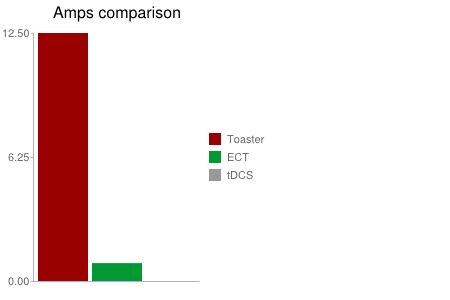Zap the Brain? Electric Stimulation and Pain
Ever since Dr. Frankenstein first saw his monster come to life, the world has been fascinated with the use of electricity in medicine.
Though crude methods have been made famous in the movies, in the last few years transcranial direct current stimulation (tDCS) has become a serious science that has helped people with migraine, chronic facial pain, depression, post-stroke rehabilitation, and more.
It could be argued that this form of treatment is still in its infancy. After all, we still know very little about how it works and how to best use it to treat specific patients.
However, it’s a lot less brutal than you might imagine if you’re thinking of a horror film.
Let’s take for example amperes, the measurement of electrical current. A toaster may have anywhere from 9-16 amps. Electroconvulsive therapy (ECT), on the other hand, which is used to treat issues such as severe depression, typically uses 200 to 1600 milliamperes, or .2 to 1.6 amps.
The current delivered for a lot of the pain treatment we’re talking about today is typically in the range of 1-2 milliamps, or about 0.0015 amps.

Research by Dr. Alexandre DaSilva at the Headache & Orofacial Pain Effort (HOPE) Lab is giving us new insight into how tDCS may fight chronic pain issues such as migraine.
We do know that tDCS treatment can reduce migraine and headache pain. A recent study published in Frontiers In Psychiatry demonstrates how tDCS might work to reduce pain.
Researchers watched what happened during treatment using a specially designed radiotracer and a PET scan. The idea was to measure µ-opioid release.
Without getting into too much detail, you might already be able to guess how this works in the end. Opiates such as morphine impact the same system in the brain, and help fight pain. In short, the plan is to use tDCS to stimulate the natural systems of the body to alleviate pain.
Dr. DaSilva says (as quoted in ScienceDaily):
This is arguably the main resource in the brain to reduce pain. We’re stimulating the release of our (body’s) own resources to provide analgesia. Instead of giving more pharmaceutical opiates, we are directly targeting and activating the same areas in the brain on which they work. (Therefore), we can increase the power of this pain-killing effect and even decrease the use of opiates in general, and consequently avoid their side effects, including addiction.
Dr. James Fugedy has been using tDCS to treat pain for the past few years. He started with fibromyalgia, and has since helped patients with migraine, depression, and chronic daily headache. He writes:
Transcranial direct current stimulation (tDCS) is the most exciting innovation I’ve experienced in 30 years of practicing medicine. … The tDCS procedure itself is simple, but protocols have evolved and results have improved. The numerous but small studies done thus far indicate, but do not yet conclusively prove benefit. Large multi-center studies need to be done to verify outcomes. Still, there is enough evidence at this time to justify clinical use for the treatment-resistant patient, particularly when you consider that there are no negative side effects with tDCS.
Future studies will be designed to provide more solid evidence of benefit, and show us which type of treatment works the best for which type of patient.
We also need to know more about how to help patients long term. How frequent do treatments need to be for patients with chronic headache? For example, could a six-week treatment regime lead to permanent results?
Meanwhile, some doctors are increasingly using tDCS to treat chronic pain. So far, this treatment has an excellent track record. Patients need to start asking their doctors about it, and pushing for further research.

dr_fi
8 January 2013 @ 4:25 pm
RT @migraine_blog: Zap the Brain? Electric Stimulation and Pain: Ever since Dr. Frankenstein first saw his monst… http://t.co/lBSzOZr3
8 January 2013 @ 8:15 pm
My mom had this procedure done.
8 January 2013 @ 8:42 pm
How did it go for her? Any relief?
8 January 2013 @ 9:38 pm
Unfortunately, no. She qualified for one of those trial research deals and they implanted wires from her the base of her spine all the way up to the base of her neck. And they sent electrodes in the wires to alleviate the pain of her migraines. But in her case it did not work, so after a year or so they removed the wires. She has tried everything known, she suffers terribly from migraines!!
MigraineProject
9 January 2013 @ 5:28 pm
@migraine_blog Is this what we are reduced to, electroshock and trepanning? http://t.co/AXg7ewMR Can’t we get real answers? #Migraine
11 January 2013 @ 8:26 am
Lea – this may help your mother:
http://headacheandmigrainenews.com/corrugator-muscle-surgery-and-the-migraine-trust/comment-page-1/#comment-310949
And if your mother sufferers from bruxism, (clenching if the jaw during sleep – a hard mouth splint will stop it and relax the temporalis muscles) when you open and close your mouth if there is a grinding or clicking noise – this is a classic sign of bruxism.
12 January 2013 @ 4:38 pm
I’m glad I read this. I am so sorry it didn’t work for your mom. Thank you for sharing.